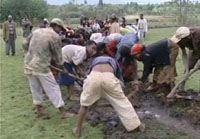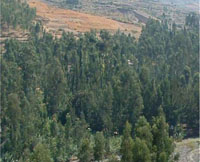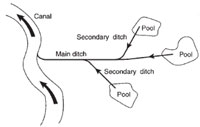9.2.2 Environmental modification
Environmental modification includes drainage, filling, land levelling and transformation of impoundment margins (e.g. ditches to restrain livestock). Although these modification works are usually of a permanent nature, proper operation and adequate maintenance are essential for their effective functioning. The following are some of the environmental modification activities useful for mosquito control:
Removal or destruction of breeding sites
Mosquitoes do not need big swamps, ponds and big water bodies to lay their eggs and complete their life cycle. Very small water collections such as in hoof-prints, abandoned cans, jars and tyres can serve as mosquito breeding grounds. Therefore, small containers serving as breeding sites can be removed, destroyed or covered to deny access to mosquitoes.
Filling breeding sites
Filling of mosquito breeding sites with soil, stones, rubble, ash or rubbish is the most permanent control measure available. It is most suitable for reducing breeding sites that do not require much filling material, such as small depressions, water holes, borrow-pits (a hole that has been excavated by people as a source of soil, stones or dirt), and abandoned ditches or pools. On a small scale, no special expertise is needed and communities can carry out the work with shovels, picks, carts and other simple equipment. The filling material should be obtained without creating new breeding sites. Waste materials can be used for most of the filling. If refuse is used, it should be compacted (pressed down hard) and covered with earth to prevent breeding by flies. Very large areas can sometimes be filled at little cost by making use of waste soil and stones left over from a construction project.
Drainage
Proper drainage reduces mosquito breeding. The drainage of water can be accomplished by constructing open waterways and dykes with tidal gates, subsoil drainage and pumping. Leakages, obstructions and small pools or puddles of residual water in drainage ditches often afford suitable breeding sites for mosquitoes. The planning and construction of some drainage systems are complicated and require the expertise of engineers. However, some small-scale drainage works intended to control mosquitoes can be carried out by community members using simple equipment (Figure 9.1).

Open ditches
Open earth drainage ditches like those in Figure 9.2 are the simplest to construct. They are used to prevent the accumulation of excess rainwater in depressions in the ground and to dry out marshy areas, borrow-pits, ground pools and other accumulations of surface water. The ditches carry the water away to an appropriate, lower-lying outlet, such as a river, stream, pond, soak away pit or main drainage ditch. They should follow the natural flow of water along the surface.
As shown in Figure 9.2, a main ditch may have several lateral or secondary ditches to collect water that does not readily drain into the main ditch.
Planting eucalyptus trees
As shown in Figure 9.3, eucalyptus trees can be used for drying marshy areas and other plots of land with a high water table. Species that grow rapidly and use a lot of water are particularly suitable. The trees dry the land by allowing water to evaporate through their leaves. For optimum evaporation they should be planted with adequate spaces between them. An additional advantage of the trees is their commercial value.

9.2.1 Environmental management for vector control

